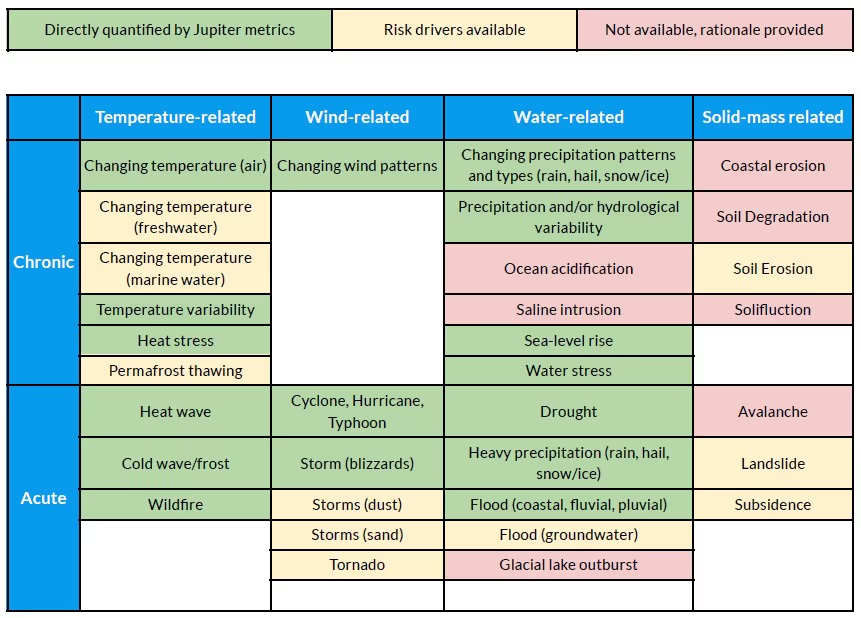.avif)
How Jupiter Empowers You to Meet Reporting Requirements
by Elisa Seith
Solutions Architect
Jupiter Intelligence
The EU Taxonomy is the centerpiece of the European Union’s Sustainable Finance Package, and assessing vulnerability caused by physical climate risk is an important activity confronting reporting companies.
With Jupiter being the global leader in physical climate risk modeling—and because it’s crucial that companies both understand the EU Taxonomy and act quickly—we’ve created a series of three, ten-minute webcasts in the run-up to its first major reporting deadline, which is December 31st for the EU’s largest companies. Our goal is to bring clarity to the Taxonomy’s requirements for physical climate risk, and articulate how decision-useful climate risk data can be put to use, now, to address them.
The first video, which I present, offers detailed information on the Taxonomy itself, its screening criteria as we know it today, and the reporting process. If you wish to jump ahead to the video, you can use this blog as a companion. To be as concise as possible, I’ll focus here on conducting vulnerability assessments, and the role that climate risk modeling plays in that process.
The ‘Sustainable Investment’ Mission, Initial Objectives, and
Screening Criteria
Before diving in, here’s a high-level view of important considerations. A key mission behind the EU Taxonomy and the Sustainable Finance Package is to enable sustainable investment in companies and sectors that support the EU’s six environmental objectives. There are six of these objectives, but in these early days, reporting criteria have been listed for only the first two: climate mitigation and climate adaptation.
For each objective, they’ve enumerated two broad criteria. To qualify as a sustainable investment under the EU Taxonomy, companies must show that their activities:
- Contribute substantially to one of its environmental objectives, AND
- Do no significant harm to any of the other objectives.
Physical Risk and Climate Vulnerability Assessments
Climate risk reporting in the EU Taxonomy has three components. The first is to identify eligible assets and activities that contribute substantially to mitigation or adaptation, and, if yes, do they do no significant harm to the other objectives? The final step is reporting to the EU the extent to which they satisfy these criteria.
The critical middle step is the physical climate risk vulnerability assessment, which enables you to understand the types of climate hazards your activities might face, and how this risk could impact their performance over the next decades and under different climate change scenarios. You then must consider adaptation measures. These assessments are vital to satisfying both the mitigation and adaptation objectives.
How Jupiter Empowers Reporting Companies
Jupiter’s state-of-the-science physical climate risk data—used today by at least one of the world’s five largest firms in asset management, banking, insurance, oil and gas, mining, power, and construction, as well as U.S. government agencies—is an essential tool across the vulnerability assessment process.

First, Jupiter helps you identify the relevant climate risk that your activity might face. The EU Taxonomy lists 33 climate perils to screen against; Jupiter metrics today directly quantify 16 of them, and we provide risk drivers for ten more. We offer robust scientific reasoning for perils we don’t cover. Jupiter offers these metrics over five-year increments through the end of the 21st century, and supports three climate scenarios spanning emission likelihoods.

To understand which activity is at risk to specific perils, Jupiter ClimateScore Global’s hazard scores give you a clear overview of an asset’s exposure by aggregating carefully selected metrics for each peril. In Figure 2, drawn from customers who use hazard scores for risk identification, 12 assets are projected as vulnerable to extreme heat by 2050, and one is at risk to both heat and fire over the same period.

You then can assess in detail how climate hazards will impact the performance of your assets by looking into the concrete peril metrics that lie behind the scores. ClimateScore Global provides 75 peril metrics, enabling you to determine the risks your assets face, to what extent, and to consider and develop adaptation measures.
With the successful completion of the vulnerability assessment, you’re free to uncork your New Year’s Eve champagne to celebrate that you’ve successfully used climate risk assessments to meet EU Taxonomy’s 2022 requirements.
Let Us Help You Make Sense of the EU Taxonomy Mandate
Jupiter is uniquely capable of offering the physical climate risk insights you need to report to the EU Taxonomy and other regulatory bodies.
- Our global market leadership is based on state-of-the-science climate models and transparent methodologies, to provide you with the most reliable and scientifically sound projections
- Our data cover the majority of the required climate hazards, and offer flexible time horizons and emissions scenarios
- Our unique combination of aggregated hazard scores and 75 detailed peril metrics empowers you to easily identify risk and assess expected impact in depth
- Our partnerships with some of the world’s biggest consultancies and auditors offer you a full range of services for sustainability reporting, if you need them
Obviously, the EU Taxonomy is too crucial and complex to describe in a single blog. So, I urge you to watch (or rewatch) our video series, and visit the EU Taxonomy hub on our website.
You’ll be able to talk to a Jupiter expert about how to use our data and services in your regulatory disclosure activities, see ClimateScore Global in action.
Elisa Seith is a Solutions Architect at Jupiter Intelligence.
Jupiter Intelligence is the global leader in climate analytics for resilience and risk management. For further information, please contact us at info@jupiterintel.com.
.webp)
